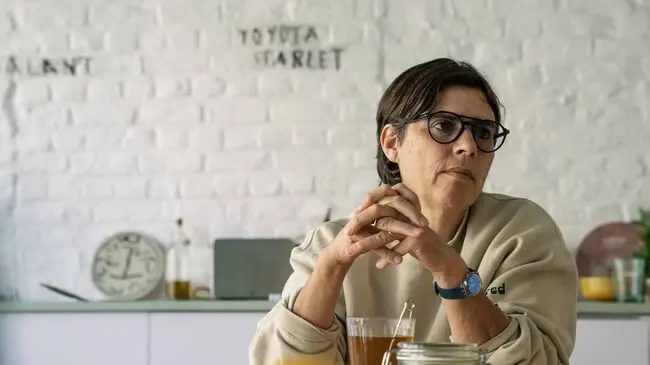Make yourself a(t) home

As house visits are a rarity these days, Design Museum Gent satisfies curious peepers with a retrospective tour around a decade of iconic interior ideas. Home Stories is not only a source of inspiration and a collection of signs of very different times: the expo also reveals several impressions of each designer’s hopes, dreams and personalities.
There’s no joy in getting a house tour through a description on the phone. So if circumstances allowed it, I probably would be out there: peeking through intriguing windows, putting notes in mailboxes, using the names of the magazines I occasionally write for as a pretext to enter someone’s private world. Because here’s the secret: I don’t consider myself a professional journalist, but rather a seasoned voyeur. Far more than the obligatory name-dropping of architects, renovation techniques, design pieces or buildings that I should be asking after, it’s the inhabitants and their personal stories that interest me the most. Where and how they come at ease; the anecdotes behind certain objects, furniture and arrangements; their rituals, favourite places, what they consider necessities in turning a house into a home. It’s the part of my questionnaire that suits the satisfaction of getting to know a person. And isn’t laying eyes on their living quarters one of the most intimate, yet effective ways to do that?


If circumstances allowed it, I probably would be out there: peeking through intriguing windows
Perhaps this is why the curators behind Home Stories chose to showcase glimpses of ideas on and around cork display counters rather than to recreate total rooms: without personal touches or presence, they would seem soulless.

Taking place in a showroom of Ikea, the scene from romcom 500 Days of Summer with which the tour starts instantly nourishes one of my beliefs. While those who have the funds will rather outsource the task of decorating to the Cecil Beaton, Elsie de Wolfe or Gert Voorjans of their time, others simply fill their house with directly available, low-cost catalogue items. On the intersection of these two extremes is the category that intrigues me the most: inspired by creatives and aversed by mainstream, they let their interior grow organically over time, mixing quirky old or original new pieces with homemade or inherited stuff, always going for the personal touch as far removed as possible from hypes or readymade options.
Inspiration can be all over the place, and it sometimes even serves as a metaphor for periodical phenomena
And yet, as the exhibition shows, the outside world always finds a way to creep in. There’s the steel skeleton and reinforced concrete elements that literally shaped Ludwig Mies van der Rohe‘s open designs, or the stones and timber Russel Wright found on his property to build a cave-like home and studio. Inspiration can be all over the place, and it sometimes even serves as a metaphor for periodical phenomena.


Think about the round and soft shapes, organic materials and tactile fabrics that I currently feel myself attracted to, most probably affected by the images I scroll through on a daily basis. These specific interior trends confirm that the world is desperately in need of safe private cocoons since last year. And maybe there is no harm in surrendering to this influence. As every period has its iconic pieces, whether it’s a Billy bookcase, a Pantone colour or a reupholstered Togo fauteuil, it’s a beautiful thought to be surrounded by keepsakes of different life phases and events.


Another topic Home Stories dedicates space to in the more recent department is a necessary one, now that the world has to rethink living: how can we still create a place to live, considering the scarcity of space and necessities? Reusing, repurposing or rethinking, as Liverpool’s The Granby Workshop does by recycling the debris generated from a local renovation project into interior objects, is a logical and smart approach. Small scale, heartwarming initiatives that merge the old with new adaptations always get me excited and hopeful. After having moved forward in the expo and backward in time, I find myself drooling over the one real room the expo has a dark, small and low-built 1920s Frankfurt kitchen. If this came with the house I bought, the cute dry food cabinet and cupboards would definitely be integrated into the renovations.
How can we still create a place to live, considering the scarcity of space and necessities?


Apart from all the exhibited impressions, the one idea that unites all former, current and future interiors is this: a home is a refuge from the outside world. It’s the one place where we can be whatever we want to be. But as recent shifts such as compulsory working from home violently disrupt our feeling of privacy, I wonder whether the sharing economy, with its small, modular and versatile spaces and other visions on future living will be put on hold. If so, will this be momentarily or permanently? Food for thought. In the meantime, let’s just all start rethinking and rearranging our own spatial autobiography, with or without a roof, zoom room, a frustration-driven hole in the wall, cocoon-friendly living sculpture sofa or Andy Warhol-like silver walls. And who knows: maybe I’ll come knocking on your door sometime soon, using the interior reportage as an alibi for asking way too many personal questions. Brace yourself.
Different Class works with the interest of their community at heart.
Our work’s purpose is to foster a solid network for independent artists, those who love them, and those who want to support them. Become a member to contribute to the local Belgian art scene.




